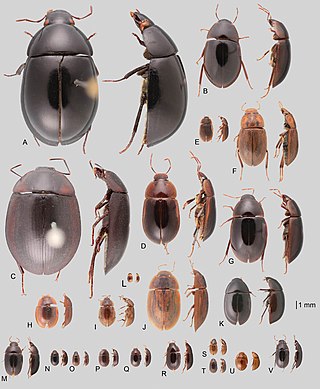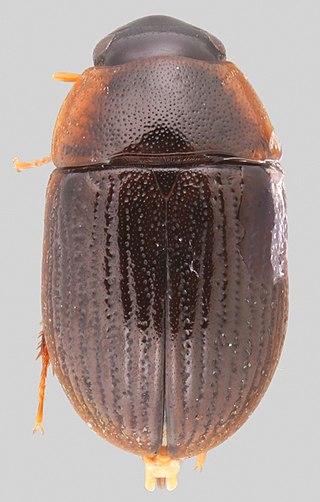
Noteridae is a family of adephagan water beetles closely related to the Dytiscidae, and formerly classified with them. They are mainly distinguished by the presence of a distinctive "noterid platform" underneath, in the form of a plate between the second and third pair of legs. The family is found worldwide, more commonly in the tropics. They are sometimes referred to as burrowing water beetles.

The Dytiscidae – based on the Greek dytikos (δυτικός), "able to dive" – are the predaceous diving beetles, a family of water beetles. They occur in virtually any freshwater habitat around the world, but a few species live among leaf litter. The adults of most are between 1 and 2.5 cm (0.4–1.0 in) long, though much variation is seen between species. The European Dytiscus latissimus and Brazilian Megadytes ducalis are the largest, reaching up to 4.5 and 4.75 cm respectively. In contrast, the smallest is likely the Australian Limbodessus atypicali of subterranean waters, which only is about 0.9 mm (0.035 in) long. Most are dark brown, blackish, or dark olive in color with golden highlights in some subfamilies. The larvae are commonly known as water tigers due to their voracious appetite. They have short, but sharp mandibles and immediately upon biting, they deliver digestive enzymes into prey to suck their liquefied remains. The family includes more than 4,000 described species in numerous genera.

Pierre François Marie Auguste Dejean, was a French soldier and entomologist. Dejean described a large number of beetles in a series of catalogues.

Louis Alexandre Auguste Chevrolat was a French entomologist. He specialized mainly on the beetles and was a founder of the Societe entomologique de France in 1832.

Charles Nicholas Aubé, was a French physician and entomologist.

Copelatus is a large genus of small diving beetles. There are some 470 described species in the genus, found worldwide, but they are most diverse in tropical South America, Africa and South-East Asia. Copelatus are often black or brown in color, many species of Copelatus possessing visible longitudinal furrows down the dorsal side of the wings of both sexes.

Rhantus is a genus of beetle in family Dytiscidae. There are about 100 species distributed worldwide. They often live in pools and marshy habitat types. Several species have colonized oceanic islands and become endemics.
Maurice Auguste Régimbart was a French entomologist who specialised in Coleoptera, particularly Dytiscidae, Gyrinidae and Hydrophilidae. Regimbart worked on expedition material collected mainly from French, Italian and Belgian colonies. He was a member of the Société entomologique de France.

Agabus is a large genus of predatory aquatic beetles in the family Dytiscidae, proposed in 1817 by William Elford Leach and named after Agabus, an early follower of Christianity. The adult beetles are moderate-sized, 5 to 14 mm long. The genus is primarily Holarctic in distribution, with only a few species known from the Afrotropical and Neotropical realms. Three species of Agabus, namely A. clypealis, A. discicollis and A. hozgargantae are endangered according to the IUCN Red List. The division into subgenera is not widely accepted. However, a number of species groups are recognized after the works of David J. Larson and Anders N. Nilsson. The genus is probably polyphyletic or paraphyletic. In a recent study of mitochondrial DNA, Agabus was found paraphyletic with respect to several of the species groups of Platambus, a closely related genus in the tribe Agabini. Lately the taxonomy of the genus has been revised, and some groups of species were transferred from Agabussensu stricto to other genera in the tribe Agabini.

Cybister, is a genus of beetle in family Dytiscidae. They are found in much of the world, including all continents except Antarctica. As of 2021 there are 96 species and 9 additional subspecies among four subgenera in the genus.

Dineutus is a genus of beetles in the family Gyrinidae, the whirligig beetles. They are 9 to 15 millimeters long. Their elytra are smooth, shallowly lined, or grooved.
Aglymbus is a genus of beetles in the family Dytiscidae, containing the following species:
Desmopachria is a genus of beetles in the family Dytiscidae, containing the following species:

Canthydrus is a genus of beetles in the family Noteridae, containing the following species:

Hydrocanthus is a genus of beetles in the family Noteridae, containing the following species:

Suphis is a genus of beetles in the family Noteridae, containing the following species:
Copelatus restrictus is a species of diving beetle. It is part of the genus Copelatus in the subfamily Copelatinae of the family Dytiscidae. It was described by Sharp in 1882.

Acidocerinae is a subfamily in the family Hydrophilidae of aquatic beetles, and it contains over 500 species in 23 genera.
Ernest (e) Allard (1820–1900) was a French entomologist who specialised in Coleoptera. He is not to be confused with the Belgian entomologist Vincent Allard (1921–1994).

Agraphydrus is a genus of water scavenger beetle in the family Hydrophilidae represented by 205 described species. It is distributed across the Afrotropical, Australasian, and Indomalayan realms.















